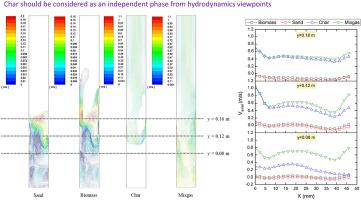Biomass & Bioenergy ( IF 5.8 ) Pub Date : 2023-04-16 , DOI: 10.1016/j.biombioe.2023.106796 S.Y. Huang , C.Y. Chen , W.Y. Hsu , A.N. Huang , H.P. Kuo

|
The Eulerian multiphase approach coupling reaction kinetic models is used to investigate a continuous rice husk fluidized bed pyrolyzer with the minimum fluidization velocity of 0.1 m/s. Considering the fact that the freshly fed biomass (terminal velocity = 0.613 m/s) and the pyrolyzed product char (terminal velocity = 0.33 m/s) show different hydrodynamic behavior, we initially consider four-phase modeling: mixgas, sand, biomass and char. The pyrolyzed products are initially detected about 0.0004 s–0.0005 s after the biomass feeding. The results confirm that char phase motion is independent to motion of other phases. The biomass entrance position determines the lowest position where the light char can possibly reach. At the fluidizing velocity of 0.3 m/s, the computational economic global kinetic model gives good char yield prediction, which deviates from the experimental result by 0.27%. The poorer bio-oil and syngas yield predictions are due to the underestimated secondary decomposition rate. At the highest fluidizing velocity of 0.4 m/s, the expanded bed pyrolyzes biomass effectively and gives the lowest unreacted biomass fraction; and the bio-oil's short residence time avoids the secondary decomposition by showing its highest fraction in the product. The highest bio-oil mass fraction of 45.5% is predicted at the reaction temperature at 500 °C.
中文翻译:

流化床反应器中生物质热解的模拟:独立的沙子、生物质和炭颗粒相
欧拉多相法耦合反应动力学模型用于研究最小流化的连续稻壳流化床热解器速度为 0.1 m/s。考虑到新喂入的生物质(终端速度 = 0.613 m/s)和热解产物焦炭(终端速度 = 0.33 m/s)表现出不同的流体动力学行为,我们最初考虑四相建模:混合气体、沙子、生物质和字符。在生物质进料后约 0.0004 s–0.0005 s 最初检测到热解产物。结果证实,炭相运动独立于其他相的运动。生物质入口位置决定了轻炭可能到达的最低位置。在流化速度为 0.3 m/s 时,计算经济全局动力学模型给出了良好的焦化率预测,与实验结果的偏差为 0.27%。较差的生物油和合成气产量预测是由于低估了二次分解率。在0.4 m / s的最高流化速度下,膨胀床有效地热解生物质并产生最低的未反应生物质分数;生物油停留时间短,在产品中的含量最高,避免了二次分解。在 500 °C 的反应温度下预测最高生物油质量分数为 45.5%。











































 京公网安备 11010802027423号
京公网安备 11010802027423号